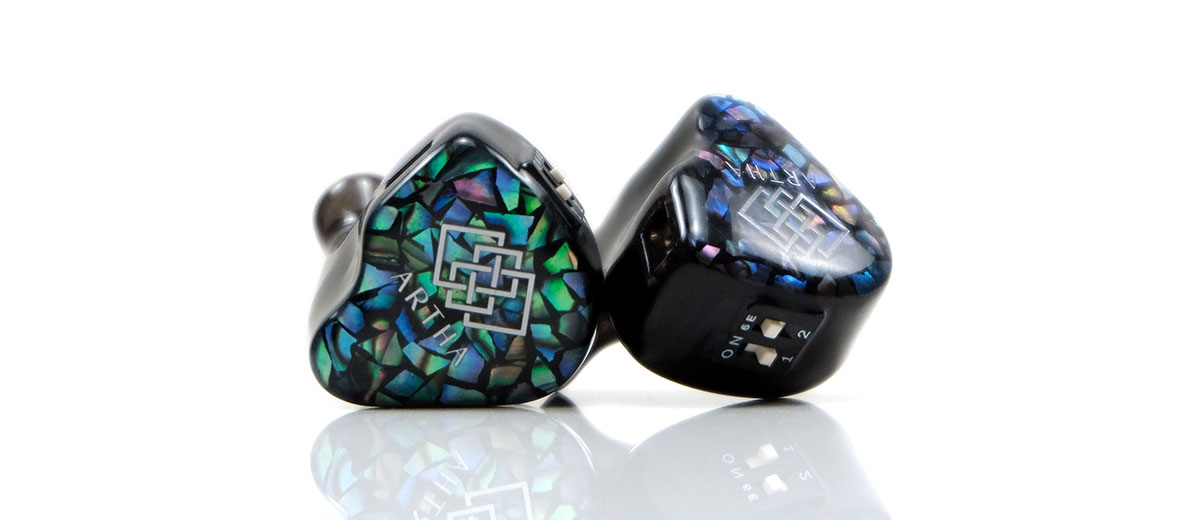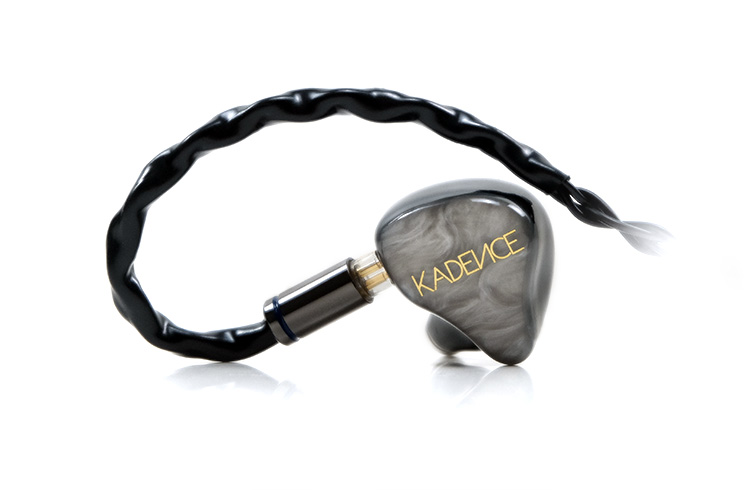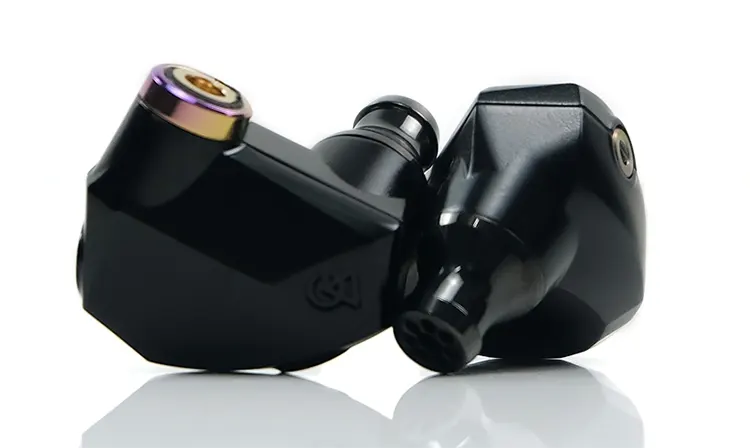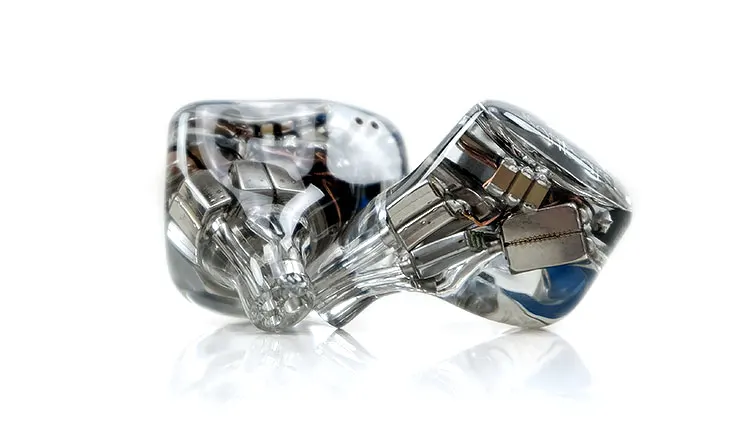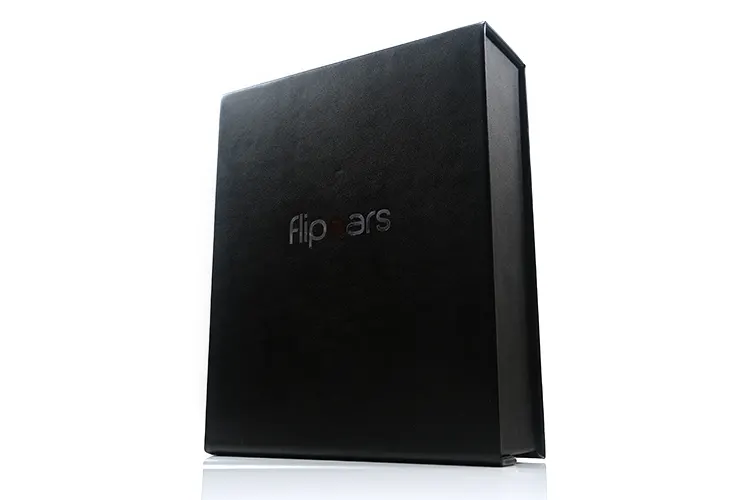Select Comparisons
The following comparisons to the FlipEars ARTHA were completed with the Eletech Baroque ear tips, using a mix of the FiiO M15S, the Chord Electronics Mojo 2, and the HiBy R8 II‘s balanced output mode in a low-gain setting.
Noble Audio Kadence
The Noble Audio Kadence was launched in late 2022 with our review shortly after in early 2023. The Kadence is a similarly priced all-BA IEM.
Technical
Both monitors are all-BA designs with 8 per side though the precise grouping is slightly different with the Kadence using 2 for the lows, 4 for the mids, and 2 for the highs.
The ARTHA divides the lows into dual woofers and an additional 2 for the lows just above, 2 for the mids, and 2 for the highs. This goes some way to explaining the enhanced low capability over the more neutral tone of the Kadence, a characteristic I will go into in more detail in the performance section below.
The Kadence is a single tuning meaning it has no dip switch capability whereas the ARTHA will give you 4 tuning profiles from its dip switch combination.
As always Noble does not reveal much technical data beyond the annotation that the Kadence is less than 35Ω and should be easy enough to drive on most dongles and DAPs.
In my review of the Kadence, I established it was much more sensitive than the Kublai Khan and on par with the Vision Ears VE8, rated at 22Ω and up to 120dB SPL @1kHz. Using iBasso’s DC-Elite balanced output the Kadence did indeed seem more sensitive than the 16Ω 118 dB/mW ARTHA but the gap isn’t huge.
Design
The ARTHA and the Kadence have extremely similar design approaches though the dip switch functionality breaks up the ARTHA flow a bit on the side of the shells, adding a bit more weight and bulk to the shells to accommodate it.
Arguably, the contouring on the Kadence resin shell is also a little more aggressive and again I would factor the dip switch space from the ARTHA into its slightly more uniform finishing at the back of the shell.
Both have elongated nozzles though the Kadence is finished with a stainless steel spout and wire gauze whereas the ARTHA is an open spout so it’s possible it can catch a bit more dirt during use.
The materials used have broadly similar approaches with two-tone resin shells comprising a piano black glossy main shell and a decorative faceplate with key material differences in the stainless steel spout of the Kadence and the dip switch module to the rear of the ARTHA.
Aesthetically, the designs are quite different. I would say the Kadence is more muted and subtle with its black and white two-tone color mix in a lava-like swirl. The ARTHA has a more striking multicolored mosaic pattern on the front plats and underside of the main shell offering more color saturation.
The comfort levels are very similar. The longer spouts and wider nozzle openings mean a deep insert and good pressure on the inside of the canals, creating a strong seal.
These are both BA IEMs so the passive isolation is excellent though the Baroque tips leak a little more than the Noble single flange tips or foam tips. Once tip-matched they have the same performance.
Performance
I was expecting to start this comparison by describing how much fuller the lows of the ARTHA sound compared to Kadence’s neutral bass tuning.
While that is true it was not the immediate standout. The initial focus was on the difference in the mids and lower treble where the Kadence has a lot more elevation from 4-8k sounding cleaner and more filled in than the darker attenuated 3-6k region of the ARTHA.
That gap does not change much with any of the ARTHA dip switches. This is more the Noble way rather than a weakness of the ARTHA.
That zesty high-energy upper mids and lower treble tuning is their stock in trade for a lot of their IEM sound signatures which can sometimes fall into a hot sibilant nightmare or like here produce a very clean sparkling sound with great percussion focus.
Even on its most treble-focused dip switch setting (1 off, 2 on), the ARTHA sounds a little darker through the upper mids and lower treble.
The ARTHA delivers a fuller sound on the lows giving it a beefier more rounded tone and a thicker note timbre.
The elevated bass response combined also injected a stronger fundamental frequency presence into the ARTHA’s low-end instrument performance which becomes a little stronger when switching to the OEM tips from the Baroque alternatives.
Vocals are much further forward in imaging from the stronger 1-3k elevation in the ARTHA FR. The Kadence is more neutral over the same range but its neutral tone and lighter bass response retain excellent space meaning performances can sound a little more complete and less vocal-focused.
I would pick the ARTHA for vocal performances and if you want a more forgiving weightier sound signature. The Kadence’s cleaner more neutral sound will appeal more to detail-orientated listeners.
Campfire Audio Fathom
The Campfire Audio Fathom was launched earlier this year, and our review was published around the same time it hit the market. The Fathom is often seen as the spiritual successor to the iconic all-BA Andromeda.
Technical
Another all-BA driver monitor, the Fathom uses 6 per side as opposed to 8 (ARTHA).
The precise grouping is two custom Knowles single diaphragm tweeters for the highs, two custom Sonion BA for the mids, and two custom dual-diaphragm Knowles woofers for the lows. There is a single crossover on the highs at around 6k as opposed to a 4-way inside the ARTHA.
The key difference here is the low-end grouping with ARTHA’s additional driver count used to split the lows between the sub-bass and bass response.
The Fathom is rated with Campfire Audio’s usual in-house benchmarking system so impedance is fairly light at 11.7Ω with 6.75Vrms required to hit 94dB @1K for SPL.
The ARTHA has a slightly higher impedance rating at 16Ω but uses the more traditional weighting system of benching marking @1kHz with an SPL of 118 dB/mW @1kHz.
Using a real-world subjective comparison using a balanced low-gain output of the HiBy R8 II the Fathom is the more sensitive of the two IEMs with a 6-step gap between it and the ARTHA for volume matching.
Design
The Fathom is a smaller, denser, and more durable monitor than the resin ARTHA. It is built from CNC-aluminum housing in a glossy black bright-dip finish accented with a rainbow PVD on the beryllium/copper MMCX connectors at the top.
Because it uses metal shells the contouring is not quite as elegant though the beveled underside has some nice touches and the prism-type angular finish on top gives the front a bit more character.
It has a smoother shell than the older Andromeda series design but is not quite as comfortable as the better contouring on the ARTHA.
I would also consider the aesthetics of the ARTHA shell to be more eye-catching though CA’s lower-tier models rarely use bright designs similar to the ARTHA. Only when you move up to the Solaris or Trifecta series do you get some seriously cool designs on their IEMs.
The shorter nozzle of the Fathom means it is more tip-dependent for passive isolation and does not insert as deep as the longer spout of the ARTHA. Using stock silicone tips on each, the ARTHA has an advantage for passive isolation though foam tips on the Fatham can close the gap.
Performance
This is a really interesting comparison because there are moments when I think the Fathom is the more capable performer and other instances when I prefer the ARTHA.
What I am hearing from the Fathom is a slightly better dynamic range, perhaps a more refined upper treble with additional headroom and staging depth.
Vocals are not as forward on the Fathom giving you a stronger sense of distance which does help with the overall perception of a nicely layered and complex imaging experience.
In contrast, the ARTHA is vocal and bass-forward, especially with both dip switches turned on. It is a simpler staging experience, not as holographic, tall, or wide-sounding as the Fathom presentation
What it does have is power with a deeper low end from 80Hz down to 20Hz. If you need the fundamental frequency to resonate strongly in your note timbre the ARTHA is the better choice.
The Fathom has a bit of attenuation sub-80Hz so it’s not quite as impactful. However, it is punchy with more bloom through the mid-to-upper bass so warmth does travel up adding some saturation to the mids coloration.
You can warm up the ARTHA lows considerably by turning on the dip switches and enhancing the bass shelf presence. However, this comes at the cost of midrange presence unless you have both switched on.
And that is where I advise leaving the switches on the ARTHA when comparing it to the Fathom. Not that it sounds similar but rather it creates a more unique sound suitable for a very different audience than a more relaxed Fathom tuning.
Softears RS10
The Softears RS10 has been out for quite a long time but still resonates strongly in the community. I believe it debuted as far back as 2018 though our review was posted in early 2022.
Technical
Internally the RS10 is a little bit ‘bigger’. Technically it uses a 10 BA driver configuration as opposed to the ARTHA’s 8, however, it also has one additional ‘passive’ driver unit which acts similarly to bone conduction drivers by vibrating passively to improve the bass response.
Although I know it uses a complex 5-way crossover, Softears does not list the precise customized BA driver grouping so it is possibly 4 for the lows, 4 for the mids, and 2 for the highs but not confirmed.
These drivers are also picked to allow the RS10 to adhere to the VDSF target response developed by their sister company, MOONDROP.
The Softears RS10 is rated at 25Ω and 100 dB/mV SPL and from our testing, this monitor does need a bit of juice to sound optimal. The ARTHA has a lower load of 16Ω but its sensitivity is measured in mW at 118 dB so much more sensitive than the RS10.
Subjectively that disparity in the ratings is confirmed by a balanced low gain volume setting of almost double for the RS10 compared to the ARTHA using the HiBy R8 II.
Design
The RS10 shells have a bigger form factor though the shaping and resin materials used are similar in application to the ARTHA. The contouring on the RS10 shells is slightly smoother with a stubbier spout and less of a lip though I find the tips stay on fairly securely.
Aesthetically, the RS10 has a plainer transparent shell but some find that a very attractive visual as it allows you to peer into the internal workings of the driver setup. I call it a nerdy exotic creative and it has its unique charm.
The RS10 spout is shorter with a slightly narrower nozzle exit that lacks a horn design. Rather the tubing bores exit at the tip directly into the ear canal so the signals mix in your ear rather than a controlled chamber similar to the ARTHA version.
Since both are contoured resin shells with BA driver configs there is no shell venting meaning passive isolation is excellent.
The choice of tips will decide the comfort levels with the RS10 sitting a little more to the edge of the ear canal and the ARTHA offering a deeper insertion with the Eletech Baroque tips.
I find the pressure from the RS10 a little bit higher but more suited to those who find deeper fits more uncomfortable. The ARTHA has a more secure fit when moving around.
Performance
With its VDSF-optimized curve, the RS10 has a more neutral but not entirely flat tuning. However, if you are after power and more coloration, the Artha is more elevated in some key areas creating a warmer, saturated sound with slightly less treble presence.
You can get close to the RS10 tuning using the ARTHA switches. With both turned off the ARTHA bass response drops a bit closer to the RS10’s equivalent and slightly below the Harman Target though its softer treble and muted upper mids still colors the mids a bit warmer.
With a stronger 3-8k elevation, I find the upper mids and highs of the RS10 to have a bit more influence on the presentation with a slightly drier neutral tone.
Once you flick on the switches, especially both at the same time, the ARTHA delivers a far weightier and fuller sound signature with the bass shelf and vocals imaging closer from 1-2k. It’s an ideal pick for heavy-hitting but uncomplicated dance music that requires a deep extension and a strong fundamental frequency.
I give credit to the RS10 lows, however. It has a fast-paced punchy mid-bass with excellent definition that marries well with fast BPM tracks that require good separation and control. With both switches on, the ARTHA can sound a little slower-paced in comparison.
The RS10 has more energy in the highs but I suspect this is more of a subjective psychoacoustic response to its stronger 6-8k peak.
Both seem to have a similar level of headroom with the ARTHA reaching deeper and pushing vocals up closer whereas the RS10 keeps these two areas more in check, reaching out a bit wider.
My Verdict
The FlipEars Artha is a professionally designed high-end IEM with a ‘vocal-first’ tuning, especially with the stock Eletech Baroque tips.
With the dip switch tuning, it’s also very flexible and will appeal to a broad range of enthusiasts looking for strong vocal delivery, impressive bass power, and a smooth midrange timbre.
Sources can pair well or not with its weakness in the muted lower treble which can rob it of some air and space behind the vocal imaging. Neutral sources with clean highs and good dynamic range and keeping the ARTHA in its balanced or HF mode can mitigate that effect.
Overall, I just wish more people heard of FlipEars, one of our best-kept secrets that has lately hit the international scene with some success. I wish them luck but with my positive experience of ARTHA, they may not need it.
Flipears ARTHA Technical Specifications
- 4-in-1 crossover
- 8 BA drivers: 2 Sub-Bass 2 Low 2 Mid 2 High
- Sensitivity: 118 dB/mW @1kHz
- Impedance: 16Ω @ 1kHz
- Frequency Response: 5Hz – 25kHz

